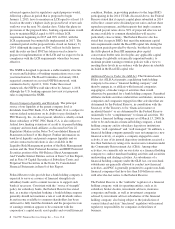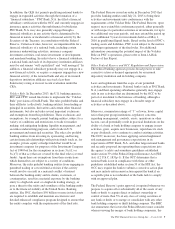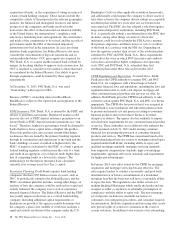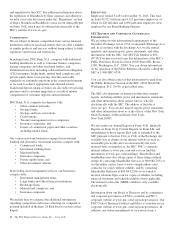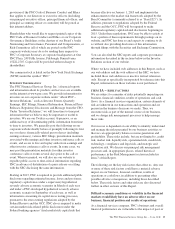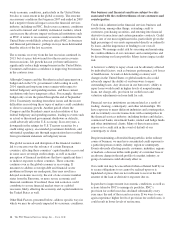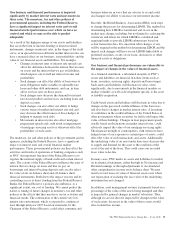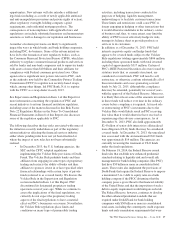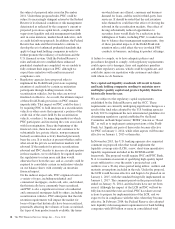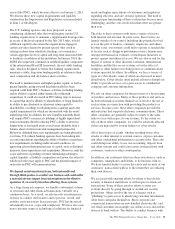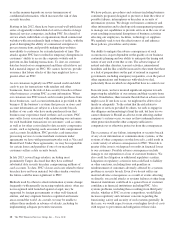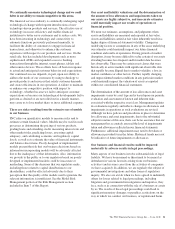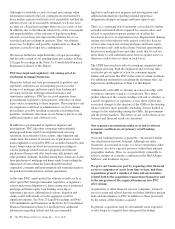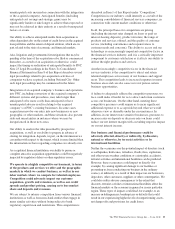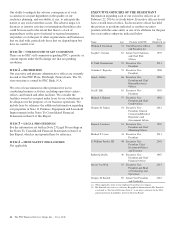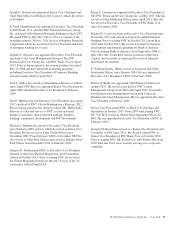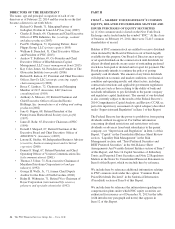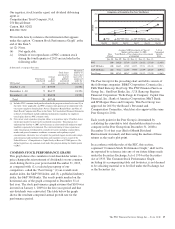PNC Bank 2013 Annual Report Download - page 35
Download and view the complete annual report
Please find page 35 of the 2013 PNC Bank annual report below. You can navigate through the pages in the report by either clicking on the pages listed below, or by using the keyword search tool below to find specific information within the annual report.opportunities. New reforms will also introduce additional
legal risk (including as a result of newly applicable antifraud
and anti-manipulation provisions and private rights of action),
affect regulatory oversight, holding company capital
requirements, and residential mortgage products. The
consequences of noncompliance with applicable laws and
regulations can include substantial monetary and nonmonetary
sanctions as well as damage to our reputation and businesses.
A number of reform provisions are likely to significantly
impact the ways in which banks and bank holding companies,
including PNC, do business. Some of the reform initiatives
have led to the formation of new regulatory bodies, such as
the Consumer Financial Protection Bureau (CFPB), which has
authority to regulate consumer financial products and services
sold by banks and non-bank companies and to supervise banks
with assets of more than $10 billion and their affiliates for
compliance with Federal consumer protection laws. Other
agencies have significant new powers relevant to PNC, such
as the authority now held by the Commodity Futures Trading
Commission (CFTC) to regulate non security-based swaps,
which, among other things, led PNC Bank, N.A. to register
with the CFTC as a swap dealer in early 2013.
See Supervision and Regulation in Item 1 of this Report for
more information concerning the regulation of PNC and
recent initiatives to reform financial institution regulation,
including some of the matters discussed in this Risk Factor.
Note 22 Regulatory Matters in the Notes To Consolidated
Financial Statements in Item 8 of this Report also discusses
some of the regulation applicable to PNC.
The following describes the key risks associated with some of
the initiatives recently undertaken as part of the regulatory
reform initiatives affecting the financial services industry,
either where pending rules have not yet been finalized or
where the impact of new rules has not been substantially
realized.
• In December 2013, the U.S. banking agencies, the
SEC and the CFTC adopted regulations
implementing the Volcker Rule provisions of Dodd-
Frank. The Volcker Rule prohibits banks and their
affiliates from engaging in some types of proprietary
trading and restricts the ability of banks and their
affiliates to sponsor, invest in or have specified other
financial relationships with certain types of private
funds (referred to as covered funds). We discuss the
Volcker Rule in the Supervision and Regulation
section included in Item 1 of this Report. PNC
discontinued its designated proprietary trading
operations several years ago. While we continue to
assess the implications of the final regulations, we
currently do not expect the proprietary trading
aspects of the final regulations to have a material
effect on PNC’s businesses or revenue. Nevertheless,
the Volcker Rule regulations place limits and
conditions on many types of permissible trading
activities, including transactions conducted for
purposes of hedging, liquidity management,
underwriting or to facilitate customer transactions.
These limits and restrictions could cause PNC to
forego engaging in hedging or other transactions that
it would otherwise undertake in the ordinary course
of business and, thus, to some extent, may limit the
ability of PNC to most effectively hedge its risks,
manage its balance sheet or provide products or
services to its customers.
• In addition, as of December 31, 2013, PNC held
interests in private equity and hedge funds that
appear to be covered funds subject to the Volcker
Rule regulations totaling approximately $806 million,
including three sponsored funds with total invested
capital of approximately $317 million. Certain of
PNC’s REIT Preferred Securities also were issued by
statutory trusts that, as currently structured, are
considered covered funds. PNC will need to sell,
restructure, or otherwise conform substantially all of
these investments and cease sponsoring covered
funds by July 21, 2015, although this compliance
date may be extended, potentially for several years,
with the approval of the Federal Reserve. Moreover,
it is likely that at least some of the amounts invested
in these funds will reduce over time in the ordinary
course before compliance is required. A forced sale
or restructuring of PNC’s investments due to the
Volcker Rule would likely result in PNC receiving
less value than it would otherwise have received or
experiencing other adverse consequences. As of
December 31, 2013, PNC also held approximately
$2.4 billion of senior debt interests in collateralized
loan obligation (CLO) funds that may be considered
covered funds. At December 31, 2013, the unrealized
loss associated with the aforementioned CLO funds
was approximately $14 million. The agencies are
currently reviewing the treatment of CLO funds
under the final regulations.
• On February 18, 2014, the Federal Reserve issued
final rules that establish new enhanced prudential
standards relating to liquidity risk and overall risk
management for bank holding companies (like PNC)
that have $50 billion or more in consolidated total
assets. These rules also implement the provisions of
Dodd-Frank that require the Federal Reserve to impose
a maximum 15-to-1 debt to equity ratio on a bank
holding company if the FSOC determines that the
company poses a grave threat to the financial stability
of the United States and that the imposition of such a
debt-to-equity requirement would mitigate such risk.
The Federal Reserve, however, continues to develop
the other enhanced prudential standards that are
required under Dodd-Frank for bank holding
companies with $50 billion or more in consolidated
total assets, including the counterparty credit exposure
limits and early remediation requirements that were
The PNC Financial Services Group, Inc. – Form 10-K 17



